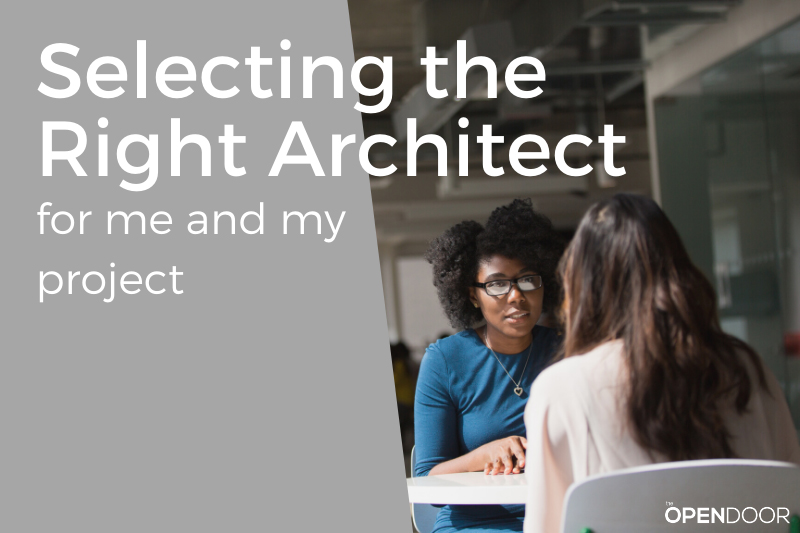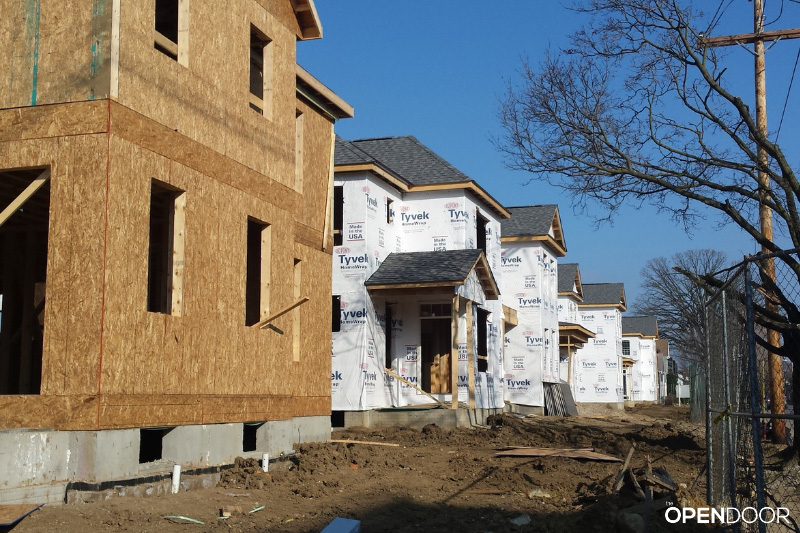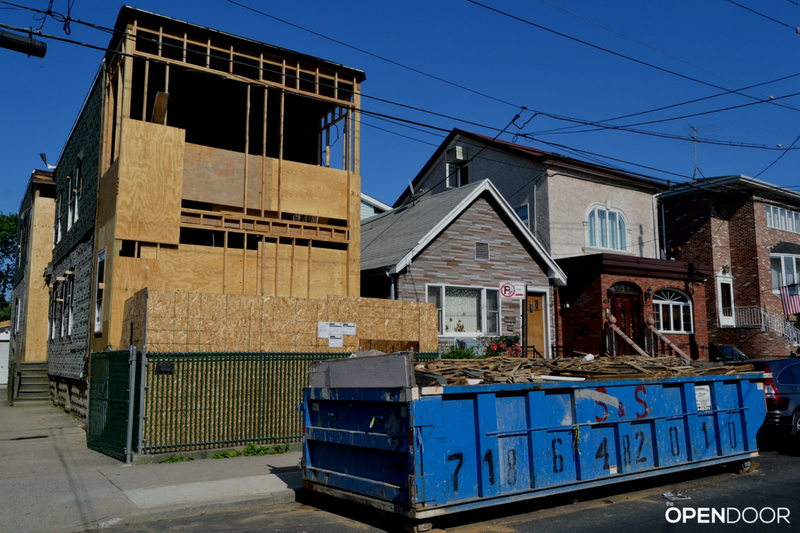One of the first steps in designing and building a custom home is selecting your architect.
Working with an architect from the very beginning adds the greatest value to your project and sets your project up for success. An architect can guide you through the rest of the project, helping to create a design that meets your goals and objectives, and then acting as your advocate (your “eyes and ears” on the job site) during construction.
In this post, we aim to provide clear guidelines for taking the first steps in finding the architecture firm that’s the best fit for you and your project.
Use these guidelines to analyze the qualifications, design strengths and weaknesses, and communication skills of your candidates. Your goal is not to find the ultimate architect, but to find the architect that is the right fit for you and your project goals so that together you can create the best possible project.
Determine your Design Goals
Before hiring an architect, confirm that an architect is the right type of design professional to work with. There are many different kinds of people who can help you create a house, but only you can decide which is best to help you create your home. There are architects, designers, draftspeople, builders, and many people in between, including design-savvy family members willing to help you design your home. Understand the difference between them, the pros and cons, and the risks and rewards associated with each.
Ask yourself, what are your design goals, and who is the best design professional to help you achieve those goals. What do you need/ want help with on your project? Is it design exploration and a unique design or a basic set of prints? How much emphasis do you want on a great design? How much are you willing to pay for design fees? Are you willing to spend more for added value and less risk? Once you understand what you need help with, you’ll more easily be able to confirm the type of design professional to work with. Your choice could be based on necessity, like having a complicated site or complex approval process, or personal preference, like wanting a unique design, wanting to explore various design ideas, wanting a licensed professional to walk you through the entire process and advocating for you, or just wanting a certain design rigor.
We’ve written in-depth on the differences between architects, designers, and draftspeople in previous blog posts. But, for a quick comparison:
An architect is a licensed design professional who plans, designs, and oversees the complex task of constructing a building. A designer or draftsperson is unlicensed. And while they may know a lot about designing buildings or drawing plans, they are not held to the same regulatory standards of ensuring the public’s health, safety, and welfare, nor are they required to have extensive education and training like an architect. For some people in some circumstances, this may be perfectly acceptable. But for others, they would rather have the reassurance and confidence that they are getting a certain level of care, expertise, and design sensibility that a licensed professional provides.
So, first step: decide if an architect is the right type of design professional for you and your needs.
Look for the Right Architect
Your next step is to start looking for good, qualified architects.
There are many places you can find architects. The easiest thing to do is an internet search. You can search for local residential architects or architects who specialize in a certain type or style of design.
You can also find qualified architects by searching and reading blog posts on topics that interest you. At YR Architecture + Design, we specialize in modern design and simple, efficient, and cost-effective solutions. We also have a knack for solving interesting design challenges, whether that involves complex or remote sites, working with existing structures, blending styles, or outside the box thinking. Some of our favorite and best clients were randomly searching online for some of these various topics and stumbled upon our website. From there, they dove into our blog content and really got to know us through our writings before reaching out to us.
Aside from general internet searches, you can also search websites like Houzz, Pinterest, professional organizations, and local architectural institutions. And then of course there is word of mouth, friends, family, and colleague referrals.
Make a shortlist of the architecture firms that pique your interest and then move on to the next step.
Familiarize Yourself with Each Architect
Do your homework. Get to know all of the architectural firms that interest you.
Review (devour) architects’ websites.
Learn as much as you can about each architect or architecture firm you’re interested in. Review their About page, their services, their philosophy, and their past work. You can gain a lot of valuable information about the firm based on how they portray themselves on their website. Do they communicate clearly? What personality does their website portray? Are they personable? What are they passionate about? What do they like to share on their website?
In reviewing their past work, ask yourself: Does their work inspire you? Are you drawn to their design sensibility? Do you like their design ethos like what they believe in and how they design?
Have a conversation
Once you learn as much as you can about the architecture firm, reach out to them and start a conversation. Before doing so, gather your thoughts on your project so that you have something of substance to talk about. Make sure you can give them a basic description of your project, rough size, budget, timeline, design style, etc.
Understand Their Process & Their Fees
Every architecture firm has a different process and way of working on projects.
Design Process
What kinds of services do they provide? Ask them to walk you through their design process. Do you want to be more hands-off or hands-on in the design process? Find out how many meetings there are, what is discussed in the meetings, and if they explore different design options or just one design. After learning about their process, do you like the level of involvement you will have with them and how they described the journey you’ll take with them?
Design Fees
When you speak with them, don’t forget to talk about how their fees are determined. Architects’ fees range from 10 to 20 percent for residential projects. When you first start the design process, you probably don’t know the final construction cost to use as an indicator, which is why it’s that much more important to discuss with each candidate how their fee structure works to get a better idea of how to budget for those soft costs.
If you have the chance, make an appointment to meet your potential architect. You’re embarking on an important relationship with your architect, so meeting them face-to-face will help you decide if you will have a productive rapport with your architect. It’s important that you and your architect can communicate clearly, openly, and comfortably.
Select the Right Architect
After researching architects, getting to know each of them and their processes, and learning everything you can about each one, it’s time to make a decision. With all this legwork behind you, you should have a good idea of which architect(s) stand out and resonate with you.
If you’re having trouble deciding and are reluctant to fully commit, ask the architecture firm if there is a low commitment offering to test out the waters. A Feasibility Study is a great low-cost commitment that not only helps you gauge whether they are a good fit, but also provides valuable information to start your design project on the right foot. A Feasibility Study would show you what your site might be able to accommodate and answers key questions regarding ballpark costs, time frames, and constraints and opportunities, thus fully preparing you for the design phase. It’s a lot easier to commit to a small introductory service like a Feasibility Study than it is to commit to the entire project, especially if you’re on the fence about whether they are the right fit for you. By engaging in a smaller service offering at the beginning, you’ll learn their work ethics, how they communicate, and the quality of service they provide which is a good indicator of how they will work with you for the rest of the project.
Final Thoughts
Keep in mind that each project is unique and that your particular requirements will differ from those of others and that there may be other important issues to address with your potential architects. But the above-mentioned steps should give you a good reference point and guide you in the general direction of the best architect for you to ensure the success of your project.
If you’re in the process of looking for a residential architect, let’s talk.










